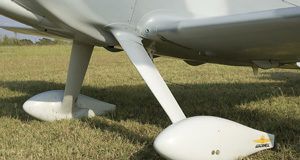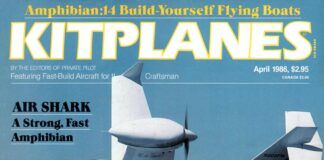A distressingly recurrent theme appears throughout accounts of flight-test scares and accident reports: The airplane had been modified in some way just before the mishap.
It is all too common for pilots to encounter difficult situations or come to grief on the first flight after a modification to the airplane. There are several situations where this can happen. Sometimes, the modification is believed to be so minor that it is unlikely to change the characteristics of the airplane. Another, and probably the most dangerous situation, is a hasty modification intended to be a quick fix for a problem discovered in earlier tests, or for some other reason.
Every airplane has areas where even small changes can have surprisingly large effects. Minor changes to the shape, surface quality or mass properties of a flying surface can result in dramatic changes to the aerodynamics and flutter dynamics.
Controls
Control surfaces are especially sensitive to small modifications—particularly those that change the mass or center of gravity of the surface. A common mistake is to reinforce a control surface by thickening the skin, or adding a ply to a layup. This makes the surface heavier and moves its CG aft from the hinge line, resulting in a reduction of critical flutter speed and making the airplane more flutter prone. Large buildups of Bondo or filler can have similar effects. Some control surfaces are so sensitive to mass balance that even painting them improperly can cause flutter. For example, the approved procedure for painting the moveable tail surfaces of one certified airplane requires that the tail be positioned with the hinge line down to prevent any paint from pooling near the trailing edge. Failure to follow this procedure has caused several flutter incidents.
Small changes to the shape of a control surface can also have large effects. Often, pilots will tailor hinge moments and control feel during a flight test through incremental changes to the trailing edge shape, or the addition of “T” strips or cord to the trailing edge. Usually this works well, but not always.
A good friend attempted to reduce the aileron forces on his aerobatic biplane by building a new set of ailerons with a modified trailing-edge shape. The modification overshot the goal of lightening roll forces, and he discovered a severe case of aileron snatch immediately after takeoff on his first flight with the new ailerons. He landed safely, but not without some scary moments on his way around the pattern. In this case, the difference of a few degrees in the included angle of the trailing edge of the ailerons resulted in a huge difference in the flying qualities of the airplane.
Adding T strips or trailing-edge wedges to the trailing edge of a trimtab, or the anti-servo tab of an all-moving tail, is risky. They alter both the mass distribution and aerodynamics of the tab in a way that can trigger flutter. I am aware of at least one accident in which the addition of a T strip to the anti-servo tab of an all-moving tail caused flutter that led to the loss of the entire tail.
Make sure that anything added to a control surface is well-secured. If part of a wedge or strip comes off or shifts in flight, the effects can range from mildly annoying to downright terrifying, and can dramatically affect controllability.
Remember that when you install a wedge or T strip, you are adding mass to the trailing edge of a control surface. This will alter the flutter envelope of the airplane, so any flutter testing performed before the trailing-edge modification was installed will no longer be valid. Flutter clearance testing must be repeated for the modified control surface to be safe.
Aerodynamics
Sometimes a small change that affects the airflow over a flying surface can have a large effect. An example was the so-called “wet canard” problem that affected several popular canard and tandem-wing homebuilts several years ago. These airplanes all had highly loaded, forward-lifting surfaces. Flying in rain, the water on the skin caused enough of a disruption to the boundary layer on the foreplane to cause a significant loss of lift as well as a large nose-down trim change that, on some airplanes, was difficult for the pilot to overcome.
A similar effect surfaced as one of the first of these machines was built. The builder took his first flights with the airplane in primer, and then painted it. His paint scheme featured a set of stripes running spanwise on the upper surface of the forward wing. When the airplane was first flown with its new paint, the rate of climb was terrible, and the airplane required a lot of up elevator to remain in the air. That tiny step between the base finish and the stripes tripped the laminar flow on the canard, and caused a large loss of lift. He didn’t think of the paint as a modification, but it greatly modified the air movement over the surface.
Haste Makes Waste
A major source of hazards is modifications made in haste, without being properly analyzed or tested before flying.
Temporary or test equipment: It is not uncommon to add equipment to an airplane that is not intended to affect the airplane’s aerodynamics or flying qualities, such as a temporary installation for gathering test data. But any installation that changes the aerodynamics or mass properties, or that can affect the functioning of flight-critical systems, must be treated as a major modification and be tested carefully.
Cameras: It is increasingly common to see cameras installed on airplanes for in-flight video, but a camera affects both the aerodynamics and the mass properties of the airplane, changing its performance and flying qualities. A famous example of a camera installation gone bad was the death of the great Art Scholl, one of the most experienced and accomplished aerobatic pilots of all time.
Scholl died on September 16, 1985, while filming for the movie Top Gun. He was performing an inverted flat spin over the Pacific Ocean, with a camera installed on his Pitts to get film for the movie. At an altitude of 3000 feet, his planned recovery altitude, he radioed, “I’ve got a problem.” As he spun down through 1500 feet he sent his last transmission, “I’ve really got a problem.” He did not recover from the spin, and was killed when the airplane hit the water and sank. Neither he nor the airplane was recovered. The NTSB report on the accident is inconclusive. It reads:
The National Transportation Safety Board determines the probable cause(s) of this accident as follows:
STALL/SPIN. INTENTIONAL. PILOT IN COMMAND
DESCENT. NOT CORRECTED. PILOT IN COMMAND.
It is widely believed that the mass of the camera installation altered the spin dynamics of the airplane enough to make it unrecoverable, as Scholl had routinely spun the unmodified airplane inverted, and recovered.
Installation of test or diagnostic equipment: Several accidents have been caused by equipment that was installed to monitor critical systems. The prototype F-14 was lost when the fittings integrating pressure-monitoring instrumentation into the hydraulic systems fatigued and failed. The installation was similar on all of the primary hydraulic systems, and all of the test fittings failed within a few minutes of each other. This disabled all hydraulics, leading to loss of control of the airplane. Both crew members ejected and survived.
Quick fixes: Probably the most dangerous type of modification is an attempt to quickly fix a problem detected during a flight test or taxi testing. Multiple accident reports describe significant modifications made in an attempt to fix something just before the mishap flight.
Ballast: One theme I see too often in accident reports is the addition of ballast. Several mishaps have occurred after ballast was added to the tail in an attempt to correct a nosewheel lift-off problem. Adding ballast, particularly if it moves the CG aft, can have a huge effect on the airplane’s stability and controllability. If you must add ballast, add it in small increments and carefully test the airplane after each increment. Adding large amounts of ballast to effect a large change in CG all in one step is a formula for disaster.
Large changes to aerodynamic configuration: Making big changes to wing incidence, tail incidence and control size or control throw are also precursors to mishaps. A large change in wing incidence probably contributed to the recent accident that claimed the life of a well-known ultralight designer/builder.
The key to safety in all situations involving changes to the configuration of an airplane is to make modifications carefully, while cautiously testing the airplane as you go along, allowing you to detect and correct any adverse characteristics before they result in disaster.

![]()
Barnaby Wainfan is a principal aerodynamics engineer for Northrop Grumman’s Advanced Design organization. A private pilot with single engine and glider ratings, Barnaby has been involved in the design of unconventional airplanes including canards, joined wings, flying wings and some too strange to fall into any known category.












